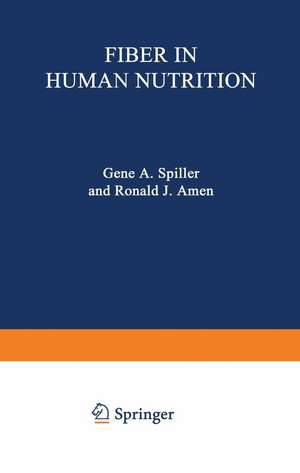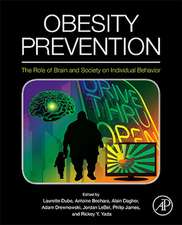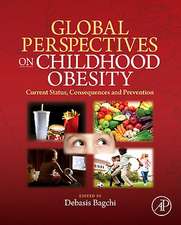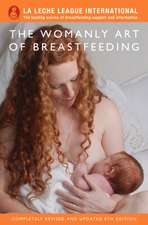Fiber in Human Nutrition
Editat de Gene Spilleren Limba Engleză Paperback – 13 mar 2012
Preț: 368.19 lei
Preț vechi: 387.58 lei
-5% Nou
Puncte Express: 552
Preț estimativ în valută:
70.45€ • 73.74$ • 58.64£
70.45€ • 73.74$ • 58.64£
Carte tipărită la comandă
Livrare economică 31 martie-14 aprilie
Preluare comenzi: 021 569.72.76
Specificații
ISBN-13: 9781468422436
ISBN-10: 146842243X
Pagini: 300
Ilustrații: XVIII, 278 p.
Dimensiuni: 152 x 229 x 16 mm
Greutate: 0.4 kg
Ediția:Softcover reprint of the original 1st ed. 1976
Editura: Springer Us
Colecția Springer
Locul publicării:New York, NY, United States
ISBN-10: 146842243X
Pagini: 300
Ilustrații: XVIII, 278 p.
Dimensiuni: 152 x 229 x 16 mm
Greutate: 0.4 kg
Ediția:Softcover reprint of the original 1st ed. 1976
Editura: Springer Us
Colecția Springer
Locul publicării:New York, NY, United States
Public țintă
ResearchCuprins
1 What Is Fiber?.- I. Introduction.- II. Development of the Concept of Fiber in Human Nutrition.- III. The Plant Cell Wall.- IV. Components of Fiber and Their Possible Physiological Significance.- V. Fiber-Associated Substances.- VI. Conclusion.- 2 The Chemistry of Dietary Fiber.- I. Introduction.- II. The Chemistry of the Individual Components.- III. Arrangement and Distribution of the Components of Dietary Fiber in Foods.- IV. Conclusions.- 3 The Analysis of Dietary Fiber.- I. Introduction and Historical Review.- II. Measurement of Fiber.- III. Measurement of Constituents of the Plant Cell Wall.- IV. Unified Procedures for Measurement of Unavailable Carbohydrates, Indigestible Residue, and Dietary Fiber.- V. Conclusions: Choice of Analytical Procedures in Studies of Dietary Fiber.- 4 Physical Properties of Fiber: A Biological Evaluation.- I. Introduction.- II. Physical Properties of Living Plant Fiber.- III. Preparation of Vegetable Fiber for Physical Characteristics Studies.- IV. Water Adsorption.- V. Ion-Exchange Capacity.- VI. Adsorption of Organic Materials to Vegetable Dietary Fiber.- VII. Surface Properties.- VIII. Relationship between Fiber and Bacteria.- IX. Effect of Bacteria on Solutes.- X. Matrix Bacterial-Solute Interaction.- XI. Summary.- 5 Microbial Activities Related to Mammalian Digestion and Absorption of Food.- I. Introduction.- II. Fermentation.- III. Food Effects on Host-Microbe Relationships.- IV. The Competition Model.- V. The Cooperation Model, with Preacid Fermentation.- VI. The Cooperation Model, with Postacid Fermentation.- VII. Types of Microorganisms.- VIII. Abnormalities in Alimentary Fermentations.- IX. Other Effects of the Microbial Ecosystem on the Host.- X. Summary and Conclusion.- 6 The Use and Function of Fiber in Diets of Monogastric Animals.- I. Introduction.- II. Fiber in Natural-Ingredient Diets.- III. Fiber in Semipurified Diets.- IV. Theories on the Health-Benefiting Role of Fiber in Diets.- V. Experimental Studies with Dietary Fiber.- VI. Conclusion.- 7 Dietary Fiber and Lipid Metabolism.- I. Introduction.- II. Early Studies.- III. Effect of Fiber on Lipids and Atherosclerosis.- IV. Possible Mechanisms of Action.- V. Summary and Conclusions.- 8 Dietary Fiber and Colon Function.- I. Introduction.- II. Effect of Fiber.- III. Dietary Fiber and Diverticular Disease.- IV. Dietary Fiber and Colonic Cancer.- V. Summary.- 9 Epidemiology of Bowel Disease.- I. Introduction.- II. Considerations in the Epidemiology of Bowel Disease.- III. Artifacts in Interpretation.- IV. Hemorrhoids.- V. Appendicitis.- VI. Constipation, Intestinal Stasis, and Consequences.- VII. Diverticular Disease.- VIII. Cancer of the Bowel.- IX. Volvulus of the Colon.- X. Inflammatory Bowel Disease.- XI. Summary.- 10 Gastrointestinal Diseases and Fiber Intake with Special Reference to South African Populations.- I. Introduction.- II. General Pattern of Changes in Diseases and Diet.- III. Diets of South African Populations.- IV. Pattern of Gastrointestinal Diseases in South African Populations.- V. Discussion.- VI. Summary.- 11 The Effects of Dietary Fiber: Are They All Good?.- I. Introduction.- II. The Evidence of Geographic Pathology.- III. The Validity of Assumptions.- IV. Proven Advantages of Dietary Fiber in Man.- V. Some Possible Side Effects of Dietary Fiber.- VI. Sources of Confusion.










